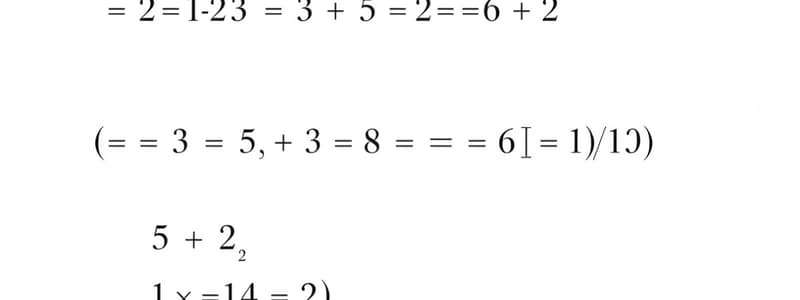Podcast
Questions and Answers
What is a function?
What is a function?
- An unordered pair of numbers
- A set of equations with no outputs
- A method to solve algebraic expressions
- A rule that establishes a relationship between two quantities (correct)
What does the domain of a function represent?
What does the domain of a function represent?
All x values (input) and independent variable
What does the range of a function represent?
What does the range of a function represent?
All y values (output) and dependent variable
What are the steps to solve functions through a mapping diagram?
What are the steps to solve functions through a mapping diagram?
What is the slope in a function?
What is the slope in a function?
What does the vertical line test determine?
What does the vertical line test determine?
What is function notation?
What is function notation?
How do you solve a function notation as f(x) = #?
How do you solve a function notation as f(x) = #?
How do you solve function notation as f(#)?
How do you solve function notation as f(#)?
What is a piecewise function?
What is a piecewise function?
What are the steps to solve piecewise functions?
What are the steps to solve piecewise functions?
What is a helpful tip when using a calculator for exponents?
What is a helpful tip when using a calculator for exponents?
Flashcards are hidden until you start studying
Study Notes
Function Fundamentals
- A function is a rule connecting input (independent variable, x) to output (dependent variable, y) with exactly one output per input.
Domain and Range
- The domain comprises all possible x values (inputs).
- The range includes all possible y values (outputs).
Mapping Diagrams
- Use a mapping diagram by labeling input and output sections.
- Ensure each input has one output; repeated inputs are not allowed, but repeated outputs are permissible.
- Determine if the relationship is a function with a concluding statement.
Solving Functions Using Tables
- Calculate slope as change in y over change in x; check for a constant rate of change.
- Locate points, preferably starting with ones having zeros or lower values for easier calculations.
- Derive function rules using the equation y = mx + b, substituting a chosen point to find b.
Vertical Line Test (VLT)
- To confirm a function graphically, draw vertical lines; if each line intersects the graph once, it qualifies as a function.
Function Notation
- Function notation represents a function defined by an equation, e.g., f(x) = mx + b.
- f(x) can substitute other letters, remaining equivalent to y.
Solving f(x) =
- Substitute the given value for f(x) into the equation, then solve to find the x value.
- Present the answer in function notation, e.g., f(3) = 10 signifies when x = 3, y is 10.
Solving f(#)
- Identify the x value from the notation to find the corresponding y.
- Input the x in the equation and solve, expressing the outcome in function notation.
Graphing Linear Functions
- Find the domain (x values) and range (y values) for the graph.
- Solve for specific f(x) and f(#) as per the problem's demand, utilizing the graph for accuracy.
Piecewise Functions
- Piecewise functions consist of segments from various functions, governed by inequalities.
Solving Piecewise Functions
- Apply the defined rules to evaluate f(#) using inequalities; create a table to categorize points.
- Distinguish between open and closed circles based on the inequalities.
- Analyze continuity based on the line's connectivity and ability to be traced without lifting the pencil.
Calculator Tips
- For exponents, enclose the number and its sign in parentheses when inputting into a calculator to ensure accuracy.
Studying That Suits You
Use AI to generate personalized quizzes and flashcards to suit your learning preferences.



